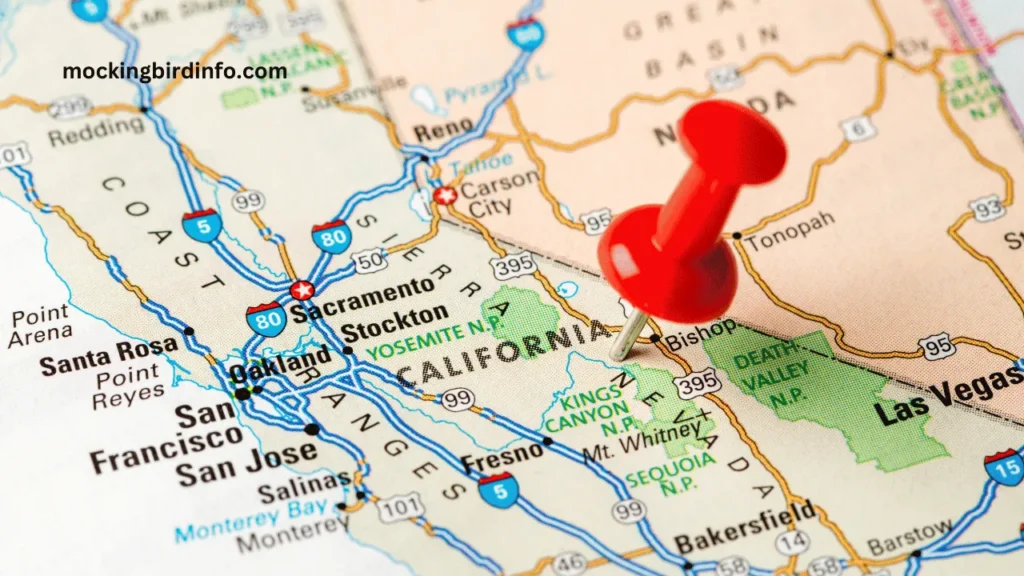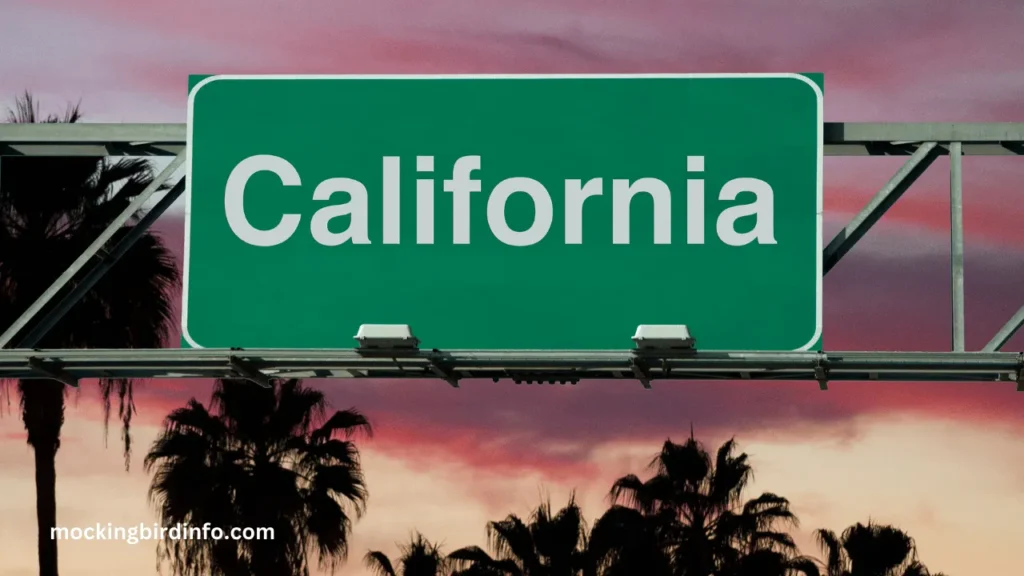Imagine stepping outside on a warm California morning, where the air is crisp, and the world is just beginning to wake up. Amid the hum of early activity, you hear a familiar song echoing in the distance.
It’s the melodic mimicry of a bird, copying the calls of other species, car alarms, and even the sound of a ringing phone. Mockingbirds, often referred to as the songbirds of adaptability, have made a place for themselves in the heart of California.
While they aren’t native to the state, they’ve become a familiar part of the Southern California landscape, and their presence raises a fascinating question—how did they get here?
The Northern Mockingbird, famous for its ability to mimic a wide range of sounds, is not originally from California. It hails from Eastern North America, where it is a beloved resident.
However, mockingbirds have found their way into California, where they now thrive in urban gardens, parks, and suburban landscapes. In this article, we will explore how mockingbirds ended up in California, the areas they inhabit, and the ecological consequences of their introduction.
From the historical context of their introduction to the current distribution in California, we’ll delve into the impacts of these birds on local ecosystems. We’ll also examine how they interact with native species and what this means for California’s biodiversity.
Join us as we uncover the journey of the mockingbird, from its Eastern roots to its Californian home, and consider the broader implications of introducing non-native species into new environments.

Contents
- 1 Native Range of Mockingbirds
- 2 Introduction to California
- 3 Current Distribution in California
- 4 Impact on the Local Ecosystem
- 5 Conservation and Management
- 6 Conclusion
- 7 FAQs
- 7.1 1. Are mockingbirds native to California?
- 7.2 2. Where can I find mockingbirds in California?
- 7.3 3. What do mockingbirds eat in California?
- 7.4 4. Why did mockingbirds come to California?
- 7.5 5. Do mockingbirds compete with native birds in California?
- 7.6 6. Can mockingbirds spread diseases to native birds?
Native Range of Mockingbirds
Mockingbirds are most commonly associated with Eastern North America, particularly the Southern United States. The Northern Mockingbird, the species that many Californians are familiar with, primarily occupies regions ranging from Texas to Florida and up through the Midwestern United States.
These birds are notorious for their vocal abilities, mimicking the sounds of other birds, animals, and even mechanical noises in their environment. Their distinct songs and territorial behavior make them easy to recognize.
Beyond the Northern Mockingbird, there are other species of mockingbirds found in different parts of the world. The Tropical Mockingbird can be found in parts of Central America and Mexico, and the Western Mockingbird is native to the Southwest U.S., including Arizona and New Mexico.
Though they share similar traits, their ranges and habitats are somewhat different, with the Northern Mockingbird being the most widespread in terms of global distribution.
It was the Northern Mockingbird, with its adaptability and resilience, that eventually made its way to California, transforming it from a bird of the Eastern United States to one of the state’s most common urban and suburban residents.
Introduction to California
The introduction of non-native birds into California is a part of the state’s ecological history. During the 19th and early 20th centuries, a wave of ornithologists, hobbyists, and garden enthusiasts began bringing birds from across the country and around the world to California, often as part of their efforts to create exotic gardens or to enhance the local wildlife.
Mockingbirds were among those birds that were introduced, either intentionally or accidentally, into the region. While not initially a part of the California ecosystem, mockingbirds quickly adapted to their new environment.
Their resilient nature, their ability to mimic a variety of sounds, and their omnivorous diet (which includes fruits, insects, and seeds) allowed them to thrive in urban environments.
The role of horticulture in this introduction cannot be understated—many of the plants brought to California to support non-native birds provided the ideal habitats for mockingbirds, from lush gardens to palm trees and other exotic vegetation.

Current Distribution in California
Today, mockingbirds have established populations in much of Southern California, with Los Angeles, San Diego, and Orange County being key hotspots. In these urban areas, the birds are found in parks, suburban neighborhoods, and agricultural areas.
While they are still more common in cities, mockingbirds have spread further inland and even into Central California. The climate of Southern California is another reason mockingbirds have thrived.
With its mild winters, long summers, and abundance of urban and suburban habitats, California provides ideal conditions for these birds to establish territories. In particular, areas that feature a combination of native plants and human-made structures like fences, telephone poles, and trees offer ample nesting opportunities.
Factors like urbanization and agricultural expansion have only increased the range of mockingbirds. While the birds may still be somewhat limited in their distribution to California’s more temperate zones, their presence is growing steadily, especially in areas with constant food sources and minimal natural predators.
Impact on the Local Ecosystem
The introduction of mockingbirds has had several significant impacts on California’s local ecosystems. One of the primary concerns is the competition with native bird species. In regions where food and nesting sites are limited, mockingbirds may outcompete local species, particularly smaller songbirds that rely on similar resources.
Additionally, mockingbirds are known for their territorial behavior, and this can lead to conflicts with other birds over prime nesting sites and food resources.
Another concern is the predation on eggs and nestlings. Mockingbirds, although primarily omnivorous, have been known to raid the nests of smaller birds to steal eggs or young chicks. This behavior further exacerbates the strain on native species, particularly those already facing habitat loss or other environmental stresses.
The introduction of mockingbirds also raises the question of disease transmission. As non-native birds, mockingbirds can carry diseases that may not be present in local species. These diseases could be transmitted to other birds, potentially leading to declines in native populations.
However, not all of the effects have been negative. Mockingbirds contribute to the dispersal of seeds, helping certain plant species spread across California’s landscapes. They also assist in insect control, particularly in gardens and agricultural fields, where their feeding habits can help control pest populations.
Conservation and Management
Managing the population of non-native species like the mockingbird is a complex challenge. On one hand, mockingbirds have become an integral part of California’s wildlife, especially in urban areas.
On the other hand, their impact on native species requires careful monitoring and management. Conservation efforts in California must strike a balance between allowing these birds to thrive while protecting local ecosystems from the potential harm caused by invasive species.
In terms of controlling their spread, efforts may include habitat modification, such as planting native species to deter mockingbirds, or even targeted removal if populations reach unsustainable levels.
Monitoring and data collection are essential to understanding the full extent of the mockingbird’s impact on local wildlife and ensuring that conservation measures are as effective as possible.
The issue also involves balancing human interests. Many Californians enjoy birdwatching and appreciate the presence of mockingbirds in their neighborhoods. Ensuring that these birds continue to exist in harmony with other species while also meeting the interests of local communities is a crucial aspect of any management plan.
Conclusion
In conclusion, mockingbirds have become a significant part of California’s wildlife, despite not being native to the state. Their adaptability, territorial nature, and ability to thrive in urban environments have allowed them to establish populations in Southern California and beyond.
However, their introduction has raised important questions about the effects of non-native species on local ecosystems, particularly regarding competition with native birds, predation, and the risk of disease transmission.
The introduction of mockingbirds into California is a perfect example of the delicate balance that exists between human activity and ecological integrity. While mockingbirds have undoubtedly enhanced the birdlife in the state, their presence also reminds us of the complexities involved in managing introduced species.
It is crucial to approach this issue with responsible conservation practices, keeping both the health of the ecosystem and the interests of the public in mind. By doing so, we can ensure that mockingbirds continue to coexist peacefully with California’s native wildlife for years to come.
FAQs
1. Are mockingbirds native to California?
No, mockingbirds are not native to California. They were introduced to the state in the late 1800s and have since established populations.
2. Where can I find mockingbirds in California?
Mockingbirds are most commonly found in Southern California, particularly in areas like Los Angeles, San Diego, and Orange County.
3. What do mockingbirds eat in California?
Mockingbirds are omnivorous and feed on a wide variety of foods, including insects, fruits, seeds, and occasionally small reptiles.
4. Why did mockingbirds come to California?
Mockingbirds were introduced to California through horticultural practices and the desire to enrich local wildlife with new species.
5. Do mockingbirds compete with native birds in California?
Yes, mockingbirds can compete with native species for nesting sites, food, and territory, which can affect local bird populations.
6. Can mockingbirds spread diseases to native birds?
Yes, mockingbirds can carry diseases that may affect local bird populations, which is a concern for conservationists.
- ****
- Do mockingbirds contribute to California’s ecosystems?
Yes, mockingbirds help with insect control and seed dispersal, playing an important role in the state’s ecosystems. - How can I attract mockingbirds to my California garden?
To attract mockingbirds, provide native plants, fruiting trees, and bird feeders stocked with seeds and berries.








